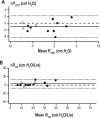Performance characteristics of upper airway critical collapsing pressure measurements during sleep
- PMID: 21461324
- PMCID: PMC3065256
- DOI: 10.1093/sleep/34.4.459
Performance characteristics of upper airway critical collapsing pressure measurements during sleep
Abstract
Objective: The critical pressure (P(CRIT)), a measurement of upper airway collapsibility, is a determinant of the severity of upper airway obstruction during sleep. We examined the performance characteristics of the passive and active P(CRIT) by examining both within-night and between-night variability in the measurements.
Methods: We studied 54 sleep apnea patients (39 men, 15 women) and 34 normal subjects (20 men, 14 women) on either 1 or 2 nights during sleep. The P(CRIT) was measured during relative hypotonia ("passive" state) or during periods of sustained upper airway obstruction used to recruit upper airway neuromuscular responses ("active" state) within- and between-nights. In a subgroup of 10 normal subjects, we performed repeated measurements during hypnotic-induced sleep. Bland-Altman analyses were used to determine the within-night and between-night reliability of the P(CRIT) measurements.
Results: There were no significant within-night or between-night differences for the mean passive P(CRIT). The active P(CRIT) was ∼1 cm H(2)O more collapsible on the second night than on the first night. The limits of agreement, which bound the passive and active P(CRIT), was ∼ ± 3 cm H(2)O and was reduced to ∼ ± 1 cm H(2)O for the passive P(CRIT) with hypnotic-induced sleep.
Conclusion: Passive and active P(CRIT) measurements are reasonably reliable within and between nights. An approximately 3 cm H(2)O change in passive or active P(CRIT) appears to represent the minimally significant change in P(CRIT) necessary to assess the effect of an intervention (e.g., positional therapy, surgical interventions, oral appliance effects, and pharmacotherapy) on upper airway mechanical loads or neuromuscular responses.
Keywords: Pharyngeal collapsibility; neuromuscular compensation; obstructive sleep apnea; sleep disordered breathing; upper airway mechanics.
Figures






References
-
- Young T, Peppard PE, Gottlieb DJ. Epidemiology of obstructive sleep apnea: A population health perspective. Am J Respir Crit Care Med. 2002;165:1217–39. - PubMed
-
- Peppard PE, Young T, Palta M, Skatrud J. Prospective study of the association between sleep-disordered breathing and hypertension. N Engl J Med. 2000;342:1378–84. - PubMed
-
- Nieto FJ, Young TB, Lind BK, et al. Association of sleep-disordered breathing, sleep apnea, and hypertension in a large community-based study. Sleep Heart Health Study. JAMA. 2000;283:1829–36. - PubMed
-
- Punjabi NM, Sorkin JD, Katzel LI, Goldberg AP, Schwartz AR, Smith PL. Sleep-disordered breathing and insulin resistance in middle-aged and overweight men. Am J Respir Crit Care Med. 2002;165:677–82. - PubMed
-
- Shahar E, Whitney CW, Redline S, et al. Sleep-disordered breathing and cardiovascular disease: cross-sectional results of the Sleep Heart Health Study. Am J Respir Crit Care Med. 2001;163:19–25. - PubMed
Publication types
MeSH terms
Grants and funding
LinkOut - more resources
Full Text Sources

